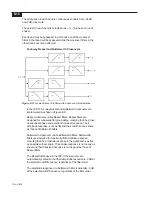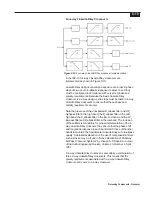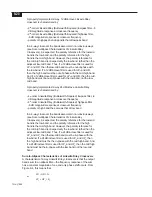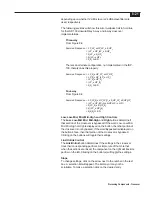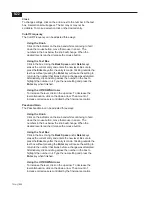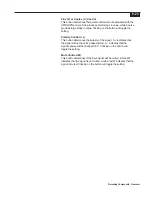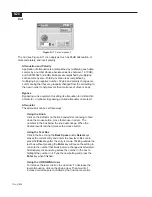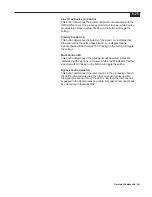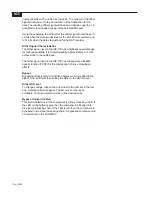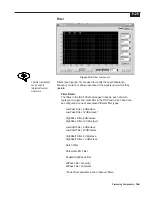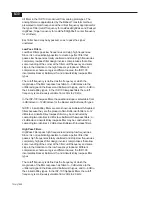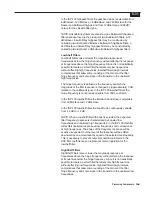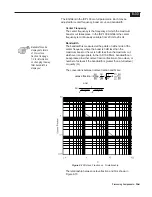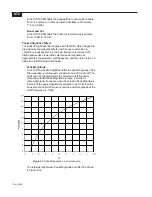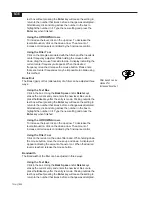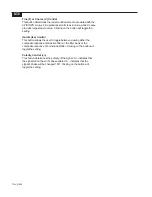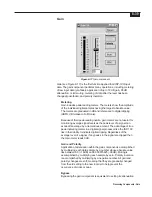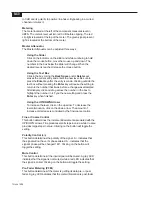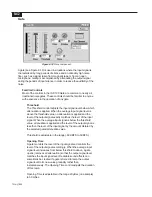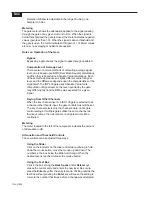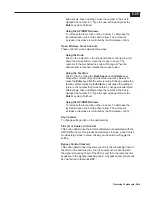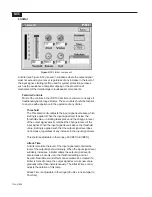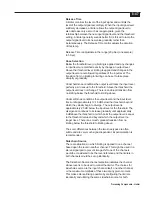
8-32
10 July 1998
The hinge frequency is defined as the frequency at which the
magnitude of the filter response is changed by (approximately) 3 dB
relative to the unfiltered signal. In the ISP-100 highshelf filters the
hinge frequency is continuously variable from 20Hz to 20 kHz.
In the ISP-100 highshelf filters the transition band slope is selectable
from 6 dB/octave and 12 dB/octave.
In the ISP-100 highshelf filters the boost/cut is continuously variable
from -12 dB to +12 dB.
NOTE: When a highshelf filter with boost is selected, the expected
filter frequency response is characterized by boosted high
frequencies and unaltered low frequencies. In the ISP-100 this filter
will exhibit unaltered response at high frequencies and cut response
at low frequencies. The shape of the frequency response will be
exactly as expected, but the level of the response will be shifted
downward by an amount exactly equal to the selected boost quantity.
This is necessary to prevent numerical overflow problems in the
DSP filter coefficients, and represents normal operation for the
highshelf filter.
Notch Filters
Notch Filters pass all frequencies except for the notch frequency,
which they stop completely. Since it is not realistically possible to
create a perfect filter that stops one frequency completely and
passes all other frequencies totally unaltered, notch filter design
involves compromises that allow some width in the notch and less
than infinite attenuation at the notch frequency.
In the ISP-100 notch filters the notch frequency is continuously
variable from 20 Hz to 20 kHz.
In the ISP-100 notch filters the notch width is continuously variable
from 1/12 octave to 1 octave.
In the ISP-100 notch filters the notch depth (attenuation at the notch
frequency) is continuously variable from -50 dB to 0 dB.
NOTE: The width of a notch filter is defined by the points on either
side of the notch at which the response is -3 dB relative to the
unaltered signal, not at the points where the response has risen +3
dB relative to the notch depth. The ISP-100 notch filters use the
correct definition of width, so a
1
/
12
octave notch in the ISP-100 is
considerably narrower than a
1
/
12
octave parametric EQ filter whose
width is defined relative to the notch depth.
Parametric EQ Filters
Equalization (EQ) filters are used to modify the frequency response
in a band of frequencies. Parametric EQ filters provide for
adjustment of all filter parameters (center frequency, boost or cut,
and bandwidth), as opposed to graphic EQ filters which have fixed
frequency and bandwidth and provide only for adjustment of boost or
cut.
Summary of Contents for Integrated Signal Processor ISP-100
Page 1: ...User s Manual ISP 100 INTEGRATED SIGNAL PROCESSOR...
Page 2: ...THIS PAGE LEFT BLANK INTENTIONALLY...
Page 24: ...2 10 10 July 1998 THIS PAGE LEFT BLANK INTENTIONALLY...
Page 32: ...3 8 10 July 1998 THIS PAGE LEFT BLANK INTENTIONALLY...
Page 48: ...5 6 10 July 1998 THIS PAGE LEFT BLANK INTENTIONALLY...
Page 126: ...A 4 10 July 1998 THIS PAGE LEFT BLANK INTENTIONALLY...
Page 128: ...B 2 10 July 1998 MONDOEQ QMS...
Page 129: ...B 3 Standard QuickMAPs 2X6CMBC QMS...
Page 130: ...B 4 10 July 1998 2X8COMB QMS...
Page 131: ...B 5 Standard QuickMAPs 3X6CMBC QMS...
Page 132: ...B 6 10 July 1998 2X8THRU QMS...
Page 133: ...B 7 Standard QuickMAPs 4CHAN QMS...
Page 134: ...B 8 10 July 1998 4X6CMBC QMS...
Page 135: ...B 9 Standard QuickMAPs 4X6THRU QMS...
Page 136: ...B 10 10 July 1998 3_2W QMS...
Page 137: ...B 11 Standard QuickMAPs 2WAYS QMS...
Page 138: ...B 12 10 July 1998 2_3WAY QMS...
Page 139: ...B 13 Standard QuickMAPs 2_2W_SUB QMS...
Page 140: ...B 14 10 July 1998 2_2W_FR QMS...
Page 141: ...B 15 Standard QuickMAPs 2_2W_2ST QMS...
Page 142: ...B 16 10 July 1998 4_2WAYS QMS...
Page 143: ...B 17 Standard QuickMAPs 4W_2FR QMS...
Page 144: ...B 18 10 July 1998 LCR QMS...
Page 145: ...B 19 Standard QuickMAPs MONO3W QMS...

